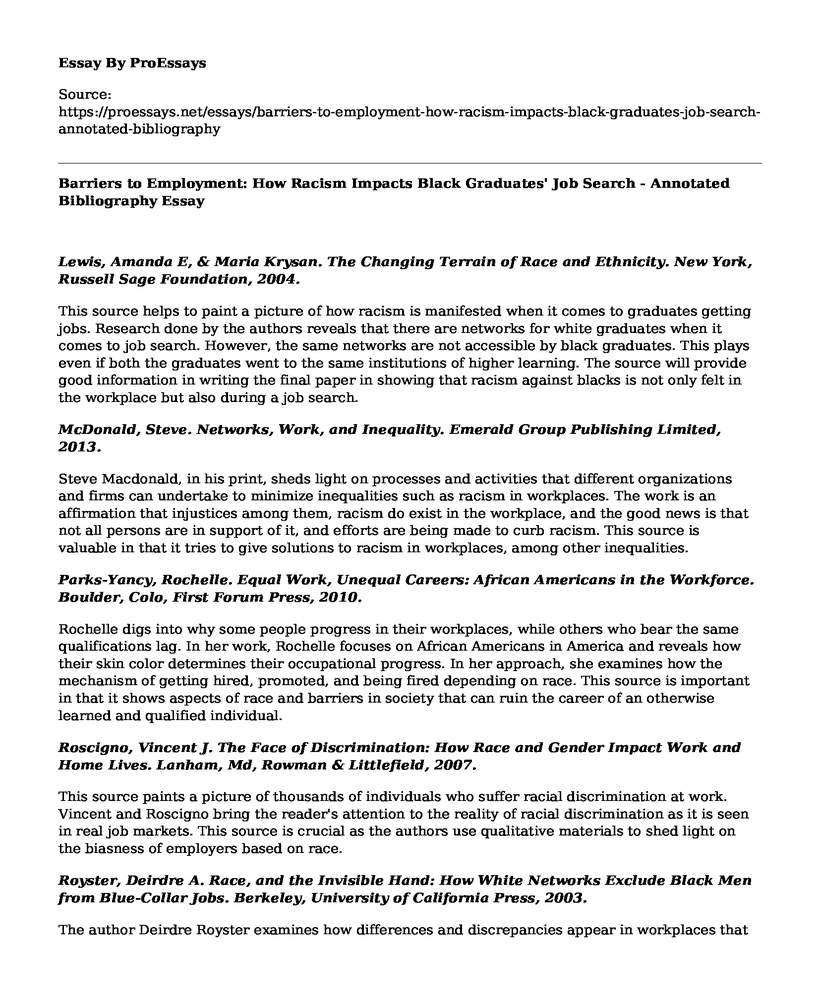Lewis, Amanda E, & Maria Krysan. The Changing Terrain of Race and Ethnicity. New York, Russell Sage Foundation, 2004.
This source helps to paint a picture of how racism is manifested when it comes to graduates getting jobs. Research done by the authors reveals that there are networks for white graduates when it comes to job search. However, the same networks are not accessible by black graduates. This plays even if both the graduates went to the same institutions of higher learning. The source will provide good information in writing the final paper in showing that racism against blacks is not only felt in the workplace but also during a job search.
McDonald, Steve. Networks, Work, and Inequality. Emerald Group Publishing Limited, 2013.
Steve Macdonald, in his print, sheds light on processes and activities that different organizations and firms can undertake to minimize inequalities such as racism in workplaces. The work is an affirmation that injustices among them, racism do exist in the workplace, and the good news is that not all persons are in support of it, and efforts are being made to curb racism. This source is valuable in that it tries to give solutions to racism in workplaces, among other inequalities.
Parks-Yancy, Rochelle. Equal Work, Unequal Careers: African Americans in the Workforce. Boulder, Colo, First Forum Press, 2010.
Rochelle digs into why some people progress in their workplaces, while others who bear the same qualifications lag. In her work, Rochelle focuses on African Americans in America and reveals how their skin color determines their occupational progress. In her approach, she examines how the mechanism of getting hired, promoted, and being fired depending on race. This source is important in that it shows aspects of race and barriers in society that can ruin the career of an otherwise learned and qualified individual.
Roscigno, Vincent J. The Face of Discrimination: How Race and Gender Impact Work and Home Lives. Lanham, Md, Rowman & Littlefield, 2007.
This source paints a picture of thousands of individuals who suffer racial discrimination at work. Vincent and Roscigno bring the reader's attention to the reality of racial discrimination as it is seen in real job markets. This source is crucial as the authors use qualitative materials to shed light on the biasness of employers based on race.
Royster, Deirdre A. Race, and the Invisible Hand: How White Networks Exclude Black Men from Blue-Collar Jobs. Berkeley, University of California Press, 2003.
The author Deirdre Royster examines how differences and discrepancies appear in workplaces that seem to favor the whites over the black workers or job seekers. He goes back in time since the era of the likes of Booker T. Washington to the present times, and the trend is the same. Racism is not an upcoming vice in workplaces, and if anything, its roots are growing deeper. The source is vital as it shows that racism in workplaces favoring the whites is a vice that has existed for long and continues to thrive in many workplaces.
Schwalbe, Michael. Rigging the Game: How Inequality Is Reproduced in Everyday Life. New York, NY, Oxford Univ. Press, 2008.
Michael opens up the mind of the reader on how inequalities occur every day in the job market, mostly not in favor of blacks. The need to have a connection in an organization to get a job comes out strongly. Even though the aspect of racism is mentioned briefly, I feel the author would have gone deeper and shed more light in all its dimensions.
Wilson, George. Race, Ethnicity, and Inequality in the Us Labour Market: Critical Issues in the New Millennium. Thousand Oaks, SAGE Publisher 2007.
George Wilson, in his book, paints a picture of the century that is neither race-neutral nor color blind when it comes to the labor market. Racism in the workplace is arguably a vice that should have ended with the last century. Race and ethnicity continue to be major determinants of sustainable job opportunities in the American Job market. The source is particularly crucial in that it explores issues being addressed by sociologists as they look into racial inequalities in the American labor market.
Works Cited
Lewis, Amanda E, & Maria Krysan. The Changing Terrain of Race and Ethnicity. New York, Russell Sage Foundation, 2004.
McDonald, Steve. Networks, Work, and Inequality. Emerald Group Publishing Limited, 2013.
Parks-Yancy, Rochelle. Equal Work, Unequal Careers: African Americans in the Workforce. Boulder, Colo, First Forum Press, 2010.
Roscigno, Vincent J. The Face of Discrimination: How Race and Gender Impact Work and Home Lives. Lanham, Md, Rowman & Littlefield, 2007.
Royster, Deirdre A. Race, and the Invisible Hand: How White Networks Exclude Black Men from Blue-Collar Jobs. Berkeley, University of California Press, 2003.
Schwalbe, Michael. Rigging the Game: How Inequality Is Reproduced in Everyday Life. New York, NY, Oxford Univ. Press, 2008.
Wilson, George. Race, Ethnicity, and Inequality in the Us Labour Market: Critical Issues in the New Millennium. Thousand Oaks, SAGE Publisher, 2007.
Cite this page
Barriers to Employment: How Racism Impacts Black Graduates' Job Search - Annotated Bibliography. (2023, May 22). Retrieved from https://proessays.net/essays/barriers-to-employment-how-racism-impacts-black-graduates-job-search-annotated-bibliography
If you are the original author of this essay and no longer wish to have it published on the ProEssays website, please click below to request its removal:
- Japanese History: Causes and Consequences of the Recession Essay
- Essay Sample on Demand-Side Policies and the Great Recession of 2008
- Paper Example on Variable Cost and Fixed Cost: Explained
- Essay on Globalism & Globalization: Exploring Benefits in Modern World
- Globalization: Impact on Financial, Social and Psychological Well-Being - Research Paper
- Euro Crisis: Nine Years Later, Still Below Pre-Crisis Level - Essay Sample
- Caucus: A Separate & Private Meeting to Resolve Disputes - Essay Sample







